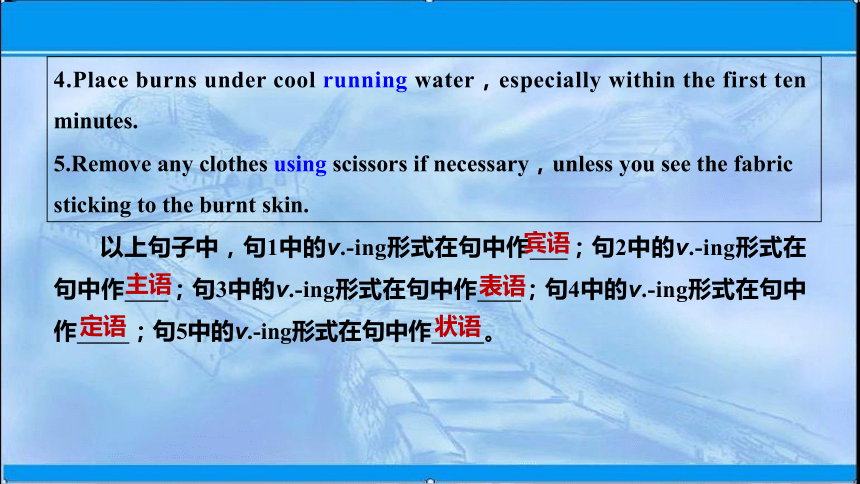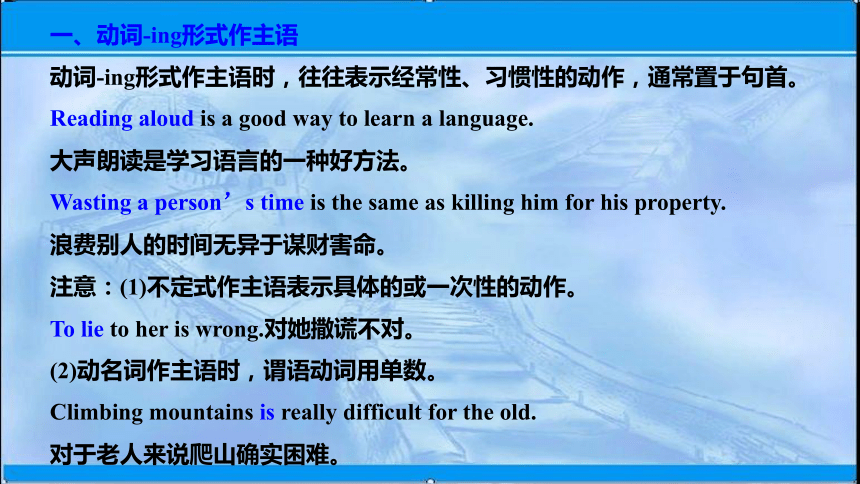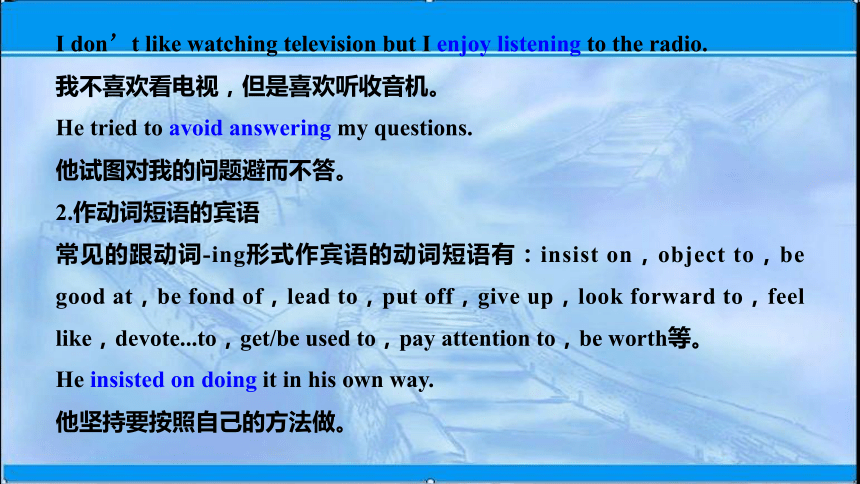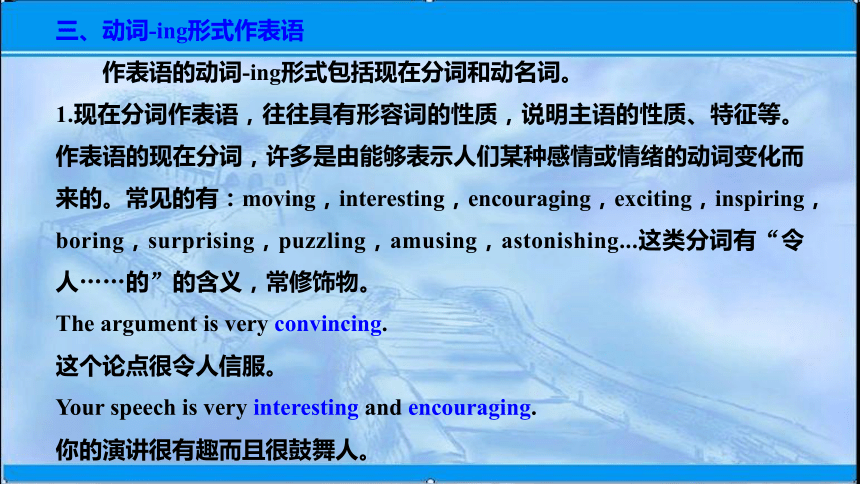人教版(2019)高中英语选择性必修2课件:Unit5 First Aid Grammar (31张)
文档属性
| 名称 | 人教版(2019)高中英语选择性必修2课件:Unit5 First Aid Grammar (31张) |  | |
| 格式 | ppt | ||
| 文件大小 | 7.2MB | ||
| 资源类型 | 教案 | ||
| 版本资源 | 人教版(2019) | ||
| 科目 | 英语 | ||
| 更新时间 | 2021-03-21 16:07:54 | ||
图片预览












文档简介
Unit 5
First Aid
Period Three
Grammar—Review of the -ing form
内容索引
4.Place burns under cool running water,especially within the first ten minutes.
5.Remove any clothes using scissors if necessary,unless you see the fabric sticking to the burnt skin.
以上句子中,句1中的v.-ing形式在句中作 ;句2中的v.-ing形式在句中作 ;句3中的v.-ing形式在句中作 ;句4中的v.-ing形式在句中作 ;句5中的v.-ing形式在句中作 。
宾语
主语
表语
定语
状语
概念:动词-ing形式是动词的一种非谓语形式,包括现在分词和动名词两种。
动词-ing形式的时态和语态:
语法精析
语态
时态
主动语态
被动语态
一般式
doing
being done
完成式
having done
having been done
动词-ing形式在句中的语法作用:动名词在句中作主语、宾语、表语和定语,现在分词在句中作表语、状语、宾语补足语和定语。
一、动词-ing形式作主语
动词-ing形式作主语时,往往表示经常性、习惯性的动作,通常置于句首。
Reading aloud is a good way to learn a language.
大声朗读是学习语言的一种好方法。
Wasting a person’s time is the same as killing him for his property.
浪费别人的时间无异于谋财害命。
注意:(1)不定式作主语表示具体的或一次性的动作。
To lie to her is wrong.对她撒谎不对。
(2)动名词作主语时,谓语动词用单数。
Climbing mountains is really difficult for the old.
对于老人来说爬山确实困难。
二、动词-ing形式作宾语
1.作动词的宾语
常接动词-ing形式作宾语的动词可用下面的口诀帮助记忆:
避免错过少延期(avoid,miss,postpone)
建议完成多练习(advise/suggest,finish,practise)
喜欢想象禁不住(enjoy,imagine,can’t help)
承认否定与嫉妒(admit,deny,envy)
逃避冒险莫原谅(escape,risk,excuse)
忍受保持不介意(stand,keep,mind)
Would you mind opening the window?
你介意打开窗子吗?
I don’t like watching television but I enjoy listening to the radio.
我不喜欢看电视,但是喜欢听收音机。
He tried to avoid answering my questions.
他试图对我的问题避而不答。
2.作动词短语的宾语
常见的跟动词-ing形式作宾语的动词短语有:insist on,object to,be good at,be fond of,lead to,put off,give up,look forward to,feel like,devote...to,get/be used to,pay attention to,be worth等。
He insisted on doing it in his own way.
他坚持要按照自己的方法做。
3.在有些动词的后面,如:start,begin,continue等既可接动名词也可接不定式作宾语,两者意义区别不大。
They continued working/to work as if nothing had happened.他们继续工作,似乎什么也没发生过。
4.有些动词(短语)后跟不定式和动词-ing形式作宾语均可,但含义不同。常见的有:
动词
宾语的形式
意义
forget
to do
忘记做……
doing
忘记做过……
remember
to do
记着要去做……
doing
记得做过……
regret
to do
遗憾/抱歉要做……
doing
后悔做了……
try
to do
尽力做……
doing
尝试做……
mean
to do
打算做……
doing
意味着……
go on
to do
接着做(另外一件事)
doing
接着做(同一件事)
stop
to do
停下来去做……
doing
停止做……
Please remember to give my best regards to your family.
请记着代我向你的家人问好。
I still remember visiting the museum for the first time.
我仍记得第一次参观博物馆的情景。
5.下列动词可接动词-ing形式的主动形式表示被动意义,相当于不定式的被动形式。
need/want/require/deserve doing=need/want/require/deserve to be done
The bike needs repairing/to be repaired.
这辆自行车需要修理。
三、动词-ing形式作表语
作表语的动词-ing形式包括现在分词和动名词。
1.现在分词作表语,往往具有形容词的性质,说明主语的性质、特征等。作表语的现在分词,许多是由能够表示人们某种感情或情绪的动词变化而来的。常见的有:moving,interesting,encouraging,exciting,inspiring,boring,surprising,puzzling,amusing,astonishing...这类分词有“令人……的”的含义,常修饰物。
The argument is very convincing.
这个论点很令人信服。
Your speech is very interesting and encouraging.
你的演讲很有趣而且很鼓舞人。
注意:不定式和动词-ed形式也可作表语,但不定式通常强调一次性的、具体的、将要发生的动作,动词-ed形式则表示被动、完成含义。
2.动名词作表语多表示抽象性的或习惯性的动作,一般说明主语的内容。
Her job is keeping the lecture hall as clean as possible.
=Keeping the lecture hall as clean as possible is her job.
她的工作是尽量使报告厅保持干净。
四、动词-ing形式作定语
动名词和现在分词都可以作定语,但有所区别。
1.动名词作定语表示被修饰词的某种性能或用途,相当于for引导的介词短语。
No one is allowed to speak aloud in the reading room.
阅览室里不准大声说话。
2.现在分词作定语时,它和被修饰词之间有逻辑上的主动关系,表示所修饰词进行的动作,相当于一个定语从句。
The boy playing football on the playground is my younger brother.
=The boy that/who is playing football on the playground is my younger brother.
在操场上踢足球的那个男孩是我的弟弟。
注意:现在分词、过去分词和不定式作定语的一般区别:现在分词表示正在进行或习惯性的动作;过去分词表示被动或完成意义;不定式表示动作尚未发生。
You should adapt to the changing situation.
你应该适应不断变化的形势。
The ground is covered with fallen leaves.
地上满是落叶。
I’m looking for a room to live in.
我正在找房子住。
五、动词-ing形式作宾语补足语
动词-ing形式作宾语补足语时,表示正在进行的动作或经常存在的状态。动词-ing形式常作以下动词的宾语补足语。
1.表示感觉和心理状态的感官动词(短语)(常见的有see,hear,feel,smell,find,notice,observe,look at,listen to等)+sb. +doing sth. (作宾补)。
I felt somebody standing behind me.
我感觉有人站在我后面。
I saw the little boy crying there.
我看到小男孩在那儿哭。
2.表示指使意义的使役动词(常见的有have,let,keep,get,leave等)+sb. /sth. +doing sth. (作宾补)。
We kept the fire burning all night long.
我们让火整夜燃烧着。
I won’t have you running about in the room.
我不允许你在房间里跑来跑去。
注意:使役动词接现在分词作宾语补足语表示“让……一直做某事”。接不带to的不定式作宾语补足语表示“让某人做某事”;接过去分词作宾语补足语,表示“主语请某人做某事,使完成某事或主语遭遇某事”。
Be careful,or you’ll have your hands hurt.
当心,否则你会弄伤手的。
3.用于with复合结构中。
I couldn’t do my homework with the noise going on.
由于噪音不断,我没法做家庭作业。
With so many people looking at her,she felt nervous.
这么多人看着她,她感到紧张。
六、现在分词作状语的用法
现在分词(短语)在句中作状语来修饰谓语动词或整个句子,表示动作发生的时间、原因、条件、结果、方式、让步或伴随状况。
1.作时间状语(相当于一个时间状语从句)。
Walking in the park,she saw an old friend.
=When/While (she was) walking in the park,she saw an old friend.
当她在公园里散步时,她看到了她的一个老朋友。
注意:当表示正在进行的动作时,可直接在分词前面加上when/while,此时也可理解为状语从句的省略。
2.作原因状语(一般可转换成由as或because引导的原因状语从句)
Being ill,he couldn’t go to school.
=As he was ill,he couldn’t go to school.
因为生病了,他无法去上学。
3.作条件状语(一般放在句首,可转换成由if,unless等连词引导的条件状语从句)
Working hard,you’ll make great progress.
=If you work hard,you’ll make great progress.
如果你努力工作,你将取得很大进步。
4.作结果状语
现在分词作结果状语时,通常放在句末,中间用逗号隔开,表示一种顺其自然、意料之中的结果。
The hospital has recently obtained new medical equipment,allowing more patients to be treated.
这家医院最近得到一批新的医疗设备,这使更多的病人能得到治疗。
注意:现在分词作结果状语,是随着谓语动词的发生而产生的自然结果,其逻辑主语往往是前面整个句子所描述的情况,前面有时候可以加thus。而不定式作结果状语时常表示出乎意料的结果,有时前面可以加only。试比较:
He was caught in the rain,thus making himself catch a cold.
被雨淋后他感冒了。
I hurried to school,only to find it was Sunday.
我匆忙赶到学校,结果发现是星期天。
5.作让步、方式和伴随状语
现在分词作让步、方式和伴随状语时,说明动作发生的背景和情况。作伴随状语时,表示分词的动作和主句的动作同时发生,此时它可转换成并列句。
Mary sat by the window of the classroom,reading a book.
=Mary sat by the window of the classroom and was reading a book.
玛丽坐在教室的窗边读一本书。
注意:
1.为强调动词-ing形式表达的意义,可在其前加上各种连词。例如,加上when,while,强调与谓语动词同时发生;加上before,after,强调动作先后发生;加上thus,强调结果;加上(al)though,强调让步等。
Though knowing all this,they made me pay for the damage.
尽管他们了解这一切,但还是让我赔偿损失。
2.当现在分词的动作先发生,而谓语动词的动作后发生时,用分词的完成式。
Having finished the letter,he went to post it.
他写完信后就把它寄了出去。(having finished是先发生的,went是后发生的)
3.动词-ing形式的否定式:not+v.-ing;not having+v.-ed
Not knowing this,he didn’t come.
他不知道这件事,所以没来。
Not having made full preparations,we put off the sports meeting.
因为没有做好充分的准备,我们把运动会延期了。
4.有些现在分词在句中没有逻辑主语,它们往往作为句子的评注性状语来修饰整个句子,表明说话者的态度、观点等。例如:generally speaking“一般来说”,judging by/from...“从……来判断”,taking everything into consideration“从全盘考虑”。
Judging from his behaviour,he must be mad.
从他的行为来判断,他一定是疯了。
返 回
Ⅰ.单句语法填空
1.On a sunny day,after lunch,she sat there, (read) a novel.
2. (not know) where to go,she went to the police for help.
3.There was a terrible noise (follow) the sudden burst of light.
4. (judge) from her letters,mother seems to be feeling a lot better.
5. (live) in Beijing for many years,Carter knew the city well.
6.Whether you like it or not, (travel) is interesting as well as tiring.
7.Though she has little education,she insists on her son (go) to college.
达 标 检 测
当堂检测 基础达标演练
reading
Not knowing
following
Judging
Having lived
travelling
going
8.The teacher told the students to stop (write) and (listen) to him.
9.They were very (excite) at the news that someone would lend them money.
10.Don’t have the students (study) all day,which will reduce their interest in study.
writing
to listen
excited
studying
Ⅱ.语法填空
Today,Mount Qomolangma’s peak is not a lonely place any more.Over 3,500 people have 11. (successful) climbed the mountain over the past years.Meanwhile,climbers have complained about 12.________
(wait) for hours in the bottlenecks.
语篇解读 这是一篇议论文。有很多人成功登顶珠峰的同时,他们遗留的垃圾也造成了环境问题。幸好有环保登山者,他们致力于清理珠峰垃圾,并做出了巨大成绩。收集的垃圾被制成艺术品陈列在尼泊尔首都,目的是提醒人们环保登峰。
successfully
waiting
解析 考查副词。climbed为动词,应用副词修饰。故填successfully。
解析 考查动名词作宾语。句中about是介词,其后接动名词作宾语。故填waiting。
In fact,the dangerous 13. (crowd) aren’t the only problem.All those climbers need 14. (bring) a lot of gear(装置) and much of them ends up being left on the mountains.Mount Qomolangma is becoming the world’s 15. (tall) rubbish dump.
crowds
解析 考查主谓一致。分析句子结构可知,提示词作为句子主语,谓语动词是are,所以主语用复数形式。故填crowds。
to bring
解析 考查非谓语动词。根据固定搭配need to do sth. (需要做某事)可知,此处应该用不定式。故填to bring。
tallest
解析 考查形容词最高级。句中的“rubbish dump”是名词词组,所以用形容词修饰,再根据句意此处为“世界最高的垃圾场”,故用形容词最高级。故填tallest。
But the good news is 16. some mountaineers are taking it upon themselves to clean up Qomolangma.Mountaineers Paul and Eberhard are part of Eco Everest Expedition which has been cleaning up rubbish since 2008.So far they 17. (collect) over 13 tons of garbage.
that
解析 考查名词性从句。分析句子结构可知,此处是表语从句,从句some mountaineers are taking it upon themselves to clean up Qomolangma的句子成分和句意都是完整的。故填that。
have collected
解析 考查时态和主谓一致。句中so far(到目前为止)是现在完成时的标志词,且主语是they,故用have done。故填have collected。
Some of that rubbish is even being used for 18. higher purpose.As part of the Mount Everest 8844 Art Project,a group of 15 artists from Nepal collected 1.5 tons of garbage.They’ve changed the cans and oxygen tanks into 74 pieces of art that have been exhibited 19. Nepal’s capital.Part of the profit from sales 20. (be) available for the Everest Peakeers Association which has helped collect tons of rubbish off the mountain.
a
解析 考查冠词。句中purpose是可数名词,根据句意可知此处不是特指,故用不定冠词。故填a。
in
解析 考查介词。根据句意可知,此处应为“在尼泊尔的首都”,所以使用介词in。故填in。
is
解析 考查时态和主谓一致。分析句子结构可知,be动词对应的主语是profit(利益,利润),是不可数名词,且根据全文判断时态为一般现在时。故填is。
返 回
Thanks
First Aid
Period Three
Grammar—Review of the -ing form
内容索引
4.Place burns under cool running water,especially within the first ten minutes.
5.Remove any clothes using scissors if necessary,unless you see the fabric sticking to the burnt skin.
以上句子中,句1中的v.-ing形式在句中作 ;句2中的v.-ing形式在句中作 ;句3中的v.-ing形式在句中作 ;句4中的v.-ing形式在句中作 ;句5中的v.-ing形式在句中作 。
宾语
主语
表语
定语
状语
概念:动词-ing形式是动词的一种非谓语形式,包括现在分词和动名词两种。
动词-ing形式的时态和语态:
语法精析
语态
时态
主动语态
被动语态
一般式
doing
being done
完成式
having done
having been done
动词-ing形式在句中的语法作用:动名词在句中作主语、宾语、表语和定语,现在分词在句中作表语、状语、宾语补足语和定语。
一、动词-ing形式作主语
动词-ing形式作主语时,往往表示经常性、习惯性的动作,通常置于句首。
Reading aloud is a good way to learn a language.
大声朗读是学习语言的一种好方法。
Wasting a person’s time is the same as killing him for his property.
浪费别人的时间无异于谋财害命。
注意:(1)不定式作主语表示具体的或一次性的动作。
To lie to her is wrong.对她撒谎不对。
(2)动名词作主语时,谓语动词用单数。
Climbing mountains is really difficult for the old.
对于老人来说爬山确实困难。
二、动词-ing形式作宾语
1.作动词的宾语
常接动词-ing形式作宾语的动词可用下面的口诀帮助记忆:
避免错过少延期(avoid,miss,postpone)
建议完成多练习(advise/suggest,finish,practise)
喜欢想象禁不住(enjoy,imagine,can’t help)
承认否定与嫉妒(admit,deny,envy)
逃避冒险莫原谅(escape,risk,excuse)
忍受保持不介意(stand,keep,mind)
Would you mind opening the window?
你介意打开窗子吗?
I don’t like watching television but I enjoy listening to the radio.
我不喜欢看电视,但是喜欢听收音机。
He tried to avoid answering my questions.
他试图对我的问题避而不答。
2.作动词短语的宾语
常见的跟动词-ing形式作宾语的动词短语有:insist on,object to,be good at,be fond of,lead to,put off,give up,look forward to,feel like,devote...to,get/be used to,pay attention to,be worth等。
He insisted on doing it in his own way.
他坚持要按照自己的方法做。
3.在有些动词的后面,如:start,begin,continue等既可接动名词也可接不定式作宾语,两者意义区别不大。
They continued working/to work as if nothing had happened.他们继续工作,似乎什么也没发生过。
4.有些动词(短语)后跟不定式和动词-ing形式作宾语均可,但含义不同。常见的有:
动词
宾语的形式
意义
forget
to do
忘记做……
doing
忘记做过……
remember
to do
记着要去做……
doing
记得做过……
regret
to do
遗憾/抱歉要做……
doing
后悔做了……
try
to do
尽力做……
doing
尝试做……
mean
to do
打算做……
doing
意味着……
go on
to do
接着做(另外一件事)
doing
接着做(同一件事)
stop
to do
停下来去做……
doing
停止做……
Please remember to give my best regards to your family.
请记着代我向你的家人问好。
I still remember visiting the museum for the first time.
我仍记得第一次参观博物馆的情景。
5.下列动词可接动词-ing形式的主动形式表示被动意义,相当于不定式的被动形式。
need/want/require/deserve doing=need/want/require/deserve to be done
The bike needs repairing/to be repaired.
这辆自行车需要修理。
三、动词-ing形式作表语
作表语的动词-ing形式包括现在分词和动名词。
1.现在分词作表语,往往具有形容词的性质,说明主语的性质、特征等。作表语的现在分词,许多是由能够表示人们某种感情或情绪的动词变化而来的。常见的有:moving,interesting,encouraging,exciting,inspiring,boring,surprising,puzzling,amusing,astonishing...这类分词有“令人……的”的含义,常修饰物。
The argument is very convincing.
这个论点很令人信服。
Your speech is very interesting and encouraging.
你的演讲很有趣而且很鼓舞人。
注意:不定式和动词-ed形式也可作表语,但不定式通常强调一次性的、具体的、将要发生的动作,动词-ed形式则表示被动、完成含义。
2.动名词作表语多表示抽象性的或习惯性的动作,一般说明主语的内容。
Her job is keeping the lecture hall as clean as possible.
=Keeping the lecture hall as clean as possible is her job.
她的工作是尽量使报告厅保持干净。
四、动词-ing形式作定语
动名词和现在分词都可以作定语,但有所区别。
1.动名词作定语表示被修饰词的某种性能或用途,相当于for引导的介词短语。
No one is allowed to speak aloud in the reading room.
阅览室里不准大声说话。
2.现在分词作定语时,它和被修饰词之间有逻辑上的主动关系,表示所修饰词进行的动作,相当于一个定语从句。
The boy playing football on the playground is my younger brother.
=The boy that/who is playing football on the playground is my younger brother.
在操场上踢足球的那个男孩是我的弟弟。
注意:现在分词、过去分词和不定式作定语的一般区别:现在分词表示正在进行或习惯性的动作;过去分词表示被动或完成意义;不定式表示动作尚未发生。
You should adapt to the changing situation.
你应该适应不断变化的形势。
The ground is covered with fallen leaves.
地上满是落叶。
I’m looking for a room to live in.
我正在找房子住。
五、动词-ing形式作宾语补足语
动词-ing形式作宾语补足语时,表示正在进行的动作或经常存在的状态。动词-ing形式常作以下动词的宾语补足语。
1.表示感觉和心理状态的感官动词(短语)(常见的有see,hear,feel,smell,find,notice,observe,look at,listen to等)+sb. +doing sth. (作宾补)。
I felt somebody standing behind me.
我感觉有人站在我后面。
I saw the little boy crying there.
我看到小男孩在那儿哭。
2.表示指使意义的使役动词(常见的有have,let,keep,get,leave等)+sb. /sth. +doing sth. (作宾补)。
We kept the fire burning all night long.
我们让火整夜燃烧着。
I won’t have you running about in the room.
我不允许你在房间里跑来跑去。
注意:使役动词接现在分词作宾语补足语表示“让……一直做某事”。接不带to的不定式作宾语补足语表示“让某人做某事”;接过去分词作宾语补足语,表示“主语请某人做某事,使完成某事或主语遭遇某事”。
Be careful,or you’ll have your hands hurt.
当心,否则你会弄伤手的。
3.用于with复合结构中。
I couldn’t do my homework with the noise going on.
由于噪音不断,我没法做家庭作业。
With so many people looking at her,she felt nervous.
这么多人看着她,她感到紧张。
六、现在分词作状语的用法
现在分词(短语)在句中作状语来修饰谓语动词或整个句子,表示动作发生的时间、原因、条件、结果、方式、让步或伴随状况。
1.作时间状语(相当于一个时间状语从句)。
Walking in the park,she saw an old friend.
=When/While (she was) walking in the park,she saw an old friend.
当她在公园里散步时,她看到了她的一个老朋友。
注意:当表示正在进行的动作时,可直接在分词前面加上when/while,此时也可理解为状语从句的省略。
2.作原因状语(一般可转换成由as或because引导的原因状语从句)
Being ill,he couldn’t go to school.
=As he was ill,he couldn’t go to school.
因为生病了,他无法去上学。
3.作条件状语(一般放在句首,可转换成由if,unless等连词引导的条件状语从句)
Working hard,you’ll make great progress.
=If you work hard,you’ll make great progress.
如果你努力工作,你将取得很大进步。
4.作结果状语
现在分词作结果状语时,通常放在句末,中间用逗号隔开,表示一种顺其自然、意料之中的结果。
The hospital has recently obtained new medical equipment,allowing more patients to be treated.
这家医院最近得到一批新的医疗设备,这使更多的病人能得到治疗。
注意:现在分词作结果状语,是随着谓语动词的发生而产生的自然结果,其逻辑主语往往是前面整个句子所描述的情况,前面有时候可以加thus。而不定式作结果状语时常表示出乎意料的结果,有时前面可以加only。试比较:
He was caught in the rain,thus making himself catch a cold.
被雨淋后他感冒了。
I hurried to school,only to find it was Sunday.
我匆忙赶到学校,结果发现是星期天。
5.作让步、方式和伴随状语
现在分词作让步、方式和伴随状语时,说明动作发生的背景和情况。作伴随状语时,表示分词的动作和主句的动作同时发生,此时它可转换成并列句。
Mary sat by the window of the classroom,reading a book.
=Mary sat by the window of the classroom and was reading a book.
玛丽坐在教室的窗边读一本书。
注意:
1.为强调动词-ing形式表达的意义,可在其前加上各种连词。例如,加上when,while,强调与谓语动词同时发生;加上before,after,强调动作先后发生;加上thus,强调结果;加上(al)though,强调让步等。
Though knowing all this,they made me pay for the damage.
尽管他们了解这一切,但还是让我赔偿损失。
2.当现在分词的动作先发生,而谓语动词的动作后发生时,用分词的完成式。
Having finished the letter,he went to post it.
他写完信后就把它寄了出去。(having finished是先发生的,went是后发生的)
3.动词-ing形式的否定式:not+v.-ing;not having+v.-ed
Not knowing this,he didn’t come.
他不知道这件事,所以没来。
Not having made full preparations,we put off the sports meeting.
因为没有做好充分的准备,我们把运动会延期了。
4.有些现在分词在句中没有逻辑主语,它们往往作为句子的评注性状语来修饰整个句子,表明说话者的态度、观点等。例如:generally speaking“一般来说”,judging by/from...“从……来判断”,taking everything into consideration“从全盘考虑”。
Judging from his behaviour,he must be mad.
从他的行为来判断,他一定是疯了。
返 回
Ⅰ.单句语法填空
1.On a sunny day,after lunch,she sat there, (read) a novel.
2. (not know) where to go,she went to the police for help.
3.There was a terrible noise (follow) the sudden burst of light.
4. (judge) from her letters,mother seems to be feeling a lot better.
5. (live) in Beijing for many years,Carter knew the city well.
6.Whether you like it or not, (travel) is interesting as well as tiring.
7.Though she has little education,she insists on her son (go) to college.
达 标 检 测
当堂检测 基础达标演练
reading
Not knowing
following
Judging
Having lived
travelling
going
8.The teacher told the students to stop (write) and (listen) to him.
9.They were very (excite) at the news that someone would lend them money.
10.Don’t have the students (study) all day,which will reduce their interest in study.
writing
to listen
excited
studying
Ⅱ.语法填空
Today,Mount Qomolangma’s peak is not a lonely place any more.Over 3,500 people have 11. (successful) climbed the mountain over the past years.Meanwhile,climbers have complained about 12.________
(wait) for hours in the bottlenecks.
语篇解读 这是一篇议论文。有很多人成功登顶珠峰的同时,他们遗留的垃圾也造成了环境问题。幸好有环保登山者,他们致力于清理珠峰垃圾,并做出了巨大成绩。收集的垃圾被制成艺术品陈列在尼泊尔首都,目的是提醒人们环保登峰。
successfully
waiting
解析 考查副词。climbed为动词,应用副词修饰。故填successfully。
解析 考查动名词作宾语。句中about是介词,其后接动名词作宾语。故填waiting。
In fact,the dangerous 13. (crowd) aren’t the only problem.All those climbers need 14. (bring) a lot of gear(装置) and much of them ends up being left on the mountains.Mount Qomolangma is becoming the world’s 15. (tall) rubbish dump.
crowds
解析 考查主谓一致。分析句子结构可知,提示词作为句子主语,谓语动词是are,所以主语用复数形式。故填crowds。
to bring
解析 考查非谓语动词。根据固定搭配need to do sth. (需要做某事)可知,此处应该用不定式。故填to bring。
tallest
解析 考查形容词最高级。句中的“rubbish dump”是名词词组,所以用形容词修饰,再根据句意此处为“世界最高的垃圾场”,故用形容词最高级。故填tallest。
But the good news is 16. some mountaineers are taking it upon themselves to clean up Qomolangma.Mountaineers Paul and Eberhard are part of Eco Everest Expedition which has been cleaning up rubbish since 2008.So far they 17. (collect) over 13 tons of garbage.
that
解析 考查名词性从句。分析句子结构可知,此处是表语从句,从句some mountaineers are taking it upon themselves to clean up Qomolangma的句子成分和句意都是完整的。故填that。
have collected
解析 考查时态和主谓一致。句中so far(到目前为止)是现在完成时的标志词,且主语是they,故用have done。故填have collected。
Some of that rubbish is even being used for 18. higher purpose.As part of the Mount Everest 8844 Art Project,a group of 15 artists from Nepal collected 1.5 tons of garbage.They’ve changed the cans and oxygen tanks into 74 pieces of art that have been exhibited 19. Nepal’s capital.Part of the profit from sales 20. (be) available for the Everest Peakeers Association which has helped collect tons of rubbish off the mountain.
a
解析 考查冠词。句中purpose是可数名词,根据句意可知此处不是特指,故用不定冠词。故填a。
in
解析 考查介词。根据句意可知,此处应为“在尼泊尔的首都”,所以使用介词in。故填in。
is
解析 考查时态和主谓一致。分析句子结构可知,be动词对应的主语是profit(利益,利润),是不可数名词,且根据全文判断时态为一般现在时。故填is。
返 回
Thanks
